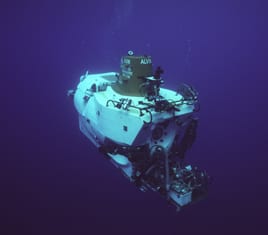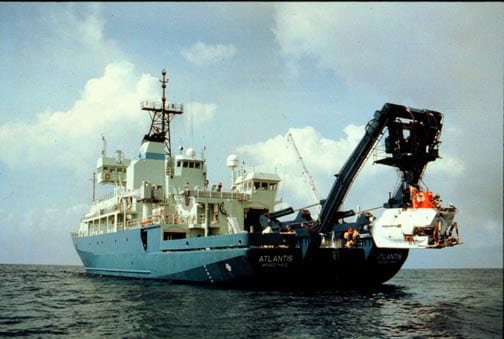Submersible ALVIN to Dive in Gulf of Mexico, Investigate Gas Hydrates and Unusual Marine Life
October 16, 2000
For the first time in eight years, the Woods Hole Oceanographic Institution’s Research Vessel Atlantis and deep-diving submersible Alvin will spend the next two weeks investigating gas hydrates, a new potential energy resource, and unusual marine life in the Gulf of Mexico. Scientists from a number of universities, government agencies and research laboratories are aboard Atlantis for the expedition, which is scheduled to depart Galveston, Texas, today. The cruise will end in Key West, Florida, on October 31. Fourteen dives are planned during the two-week expedition, including a number of dives in previously unexplored deep waters of the Gulf.
The expedition is sponsored by the National Oceanic and Atmospheric Administration (NOAA) through its National Undersea Research Center at the University of North Carolina at Wilmington. The Minerals Management Service, Department of Energy and NOAA’s National Ocean Service are sponsoring specific dives. The science team includes researchers from Texas A&M University, Louisiana State University, University of South Carolina, College of William and Mary and Channel Islands National Marine Sanctuary. In addition to the ship and submersible, Woods Hole Oceanographic Institution’s (WHOI’s) support for the expedition includes deep-sea video technologies including high definition television cameras and recording equipment on Alvin.
Research on the cruise will range from studies of gas hydrates and microbiology to intense storms on the sea floor. Gas hydrates are hydrocarbon molecules, like methane, that are trapped in ice. Many believe that most of the fossil carbon on the planet is locked up in gas hydrate deposits on the continental margins and could be a valuable potential energy resource. Scientists have been studying gas hydrates for years, among them WHOI Geochemist Jean Whelan, a specialist in oil and gas formation. Whelan’s Marine Chemistry and Geochemistry Department colleague Jeff Seewald has designed a new sampling instrument to trap the gas in situ. Whelan made a cruise to the Gulf in August and is analyzing gas hydrate samples collected on that cruise.
The three-person Alvin, the only human occupied submersible in the United States capable of diving beyond 10,000 feet, has made more than 3,600 dives since it began operation in 1964. The sub, which can dive to 4,500 meters (14,764 feet), and its support vessel, the 274-foot Atlantis, have been working in the Pacific Ocean for the past three years exploring the seafloor and conducting biological, chemical, geochemical, geological and geophysical studies. The ship and sub are part of the U.S. National Deep Submergence Facility operated by WHOI.
The vessels left Woods Hole June 2, 1997 and will return home December 16, 2000 – a three and one-half year voyage. The sub will then undergo a routine overhaul, which occurs about every three years, before resuming its diving schedule in mid-2001.


